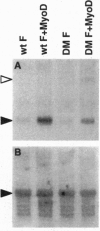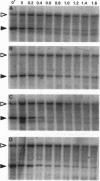Abstract
Myotonic dystrophy is caused by an expansion of a CTG triplet repeat sequence in the 3' noncoding region of a protein kinase gene, yet the mechanism by which the triplet repeat expansion causes disease remains unknown. This report demonstrates that a DNase I hypersensitive site is positioned 3' of the triplet repeat in the wild-type allele in both fibroblasts and skeletal muscle cells. In three unrelated individuals with myotonic dystrophy that have large expansions of the triplet repeat, the allele with the triplet repeat expansion exhibited both overall DNase I resistance and inaccessibility of nucleases to the adjacent hypersensitive site. These results indicate that the triplet repeat expansion alters the adjacent chromatin structure, establishing a region of condensed chromatin, and suggests a molecular mechanism for myotonic dystrophy.
Full text
PDF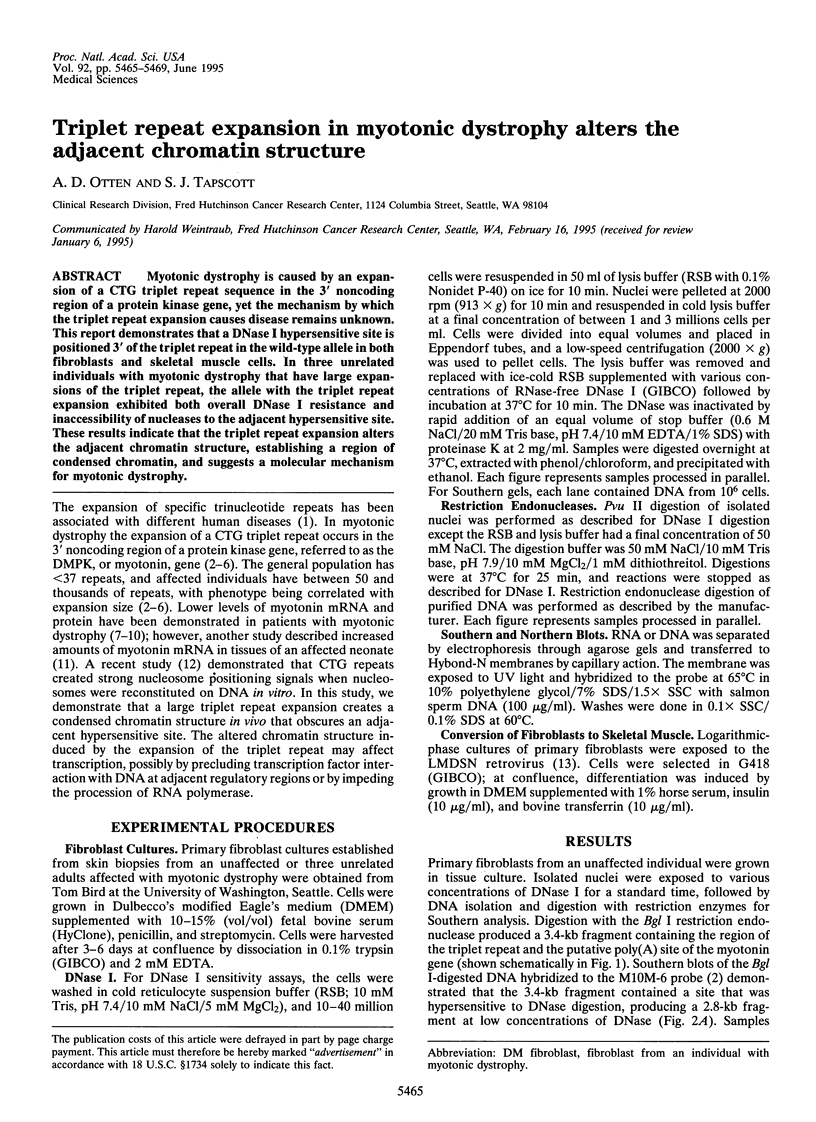
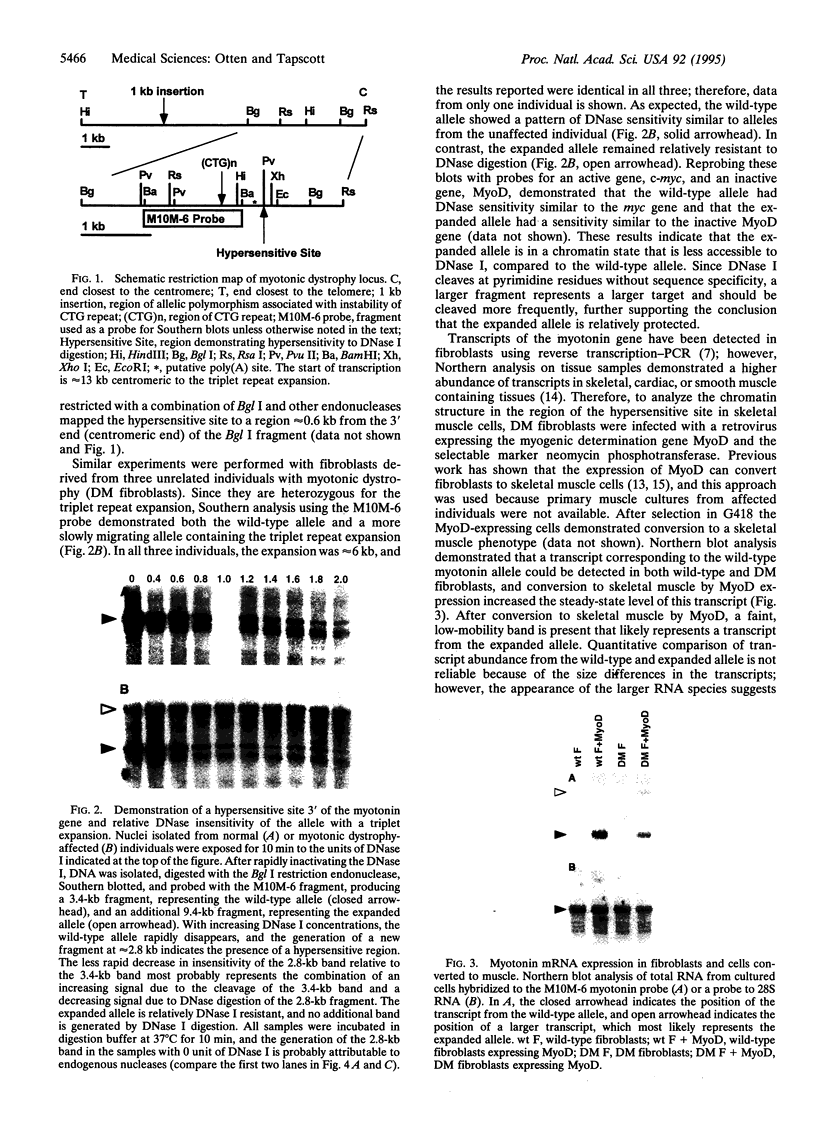
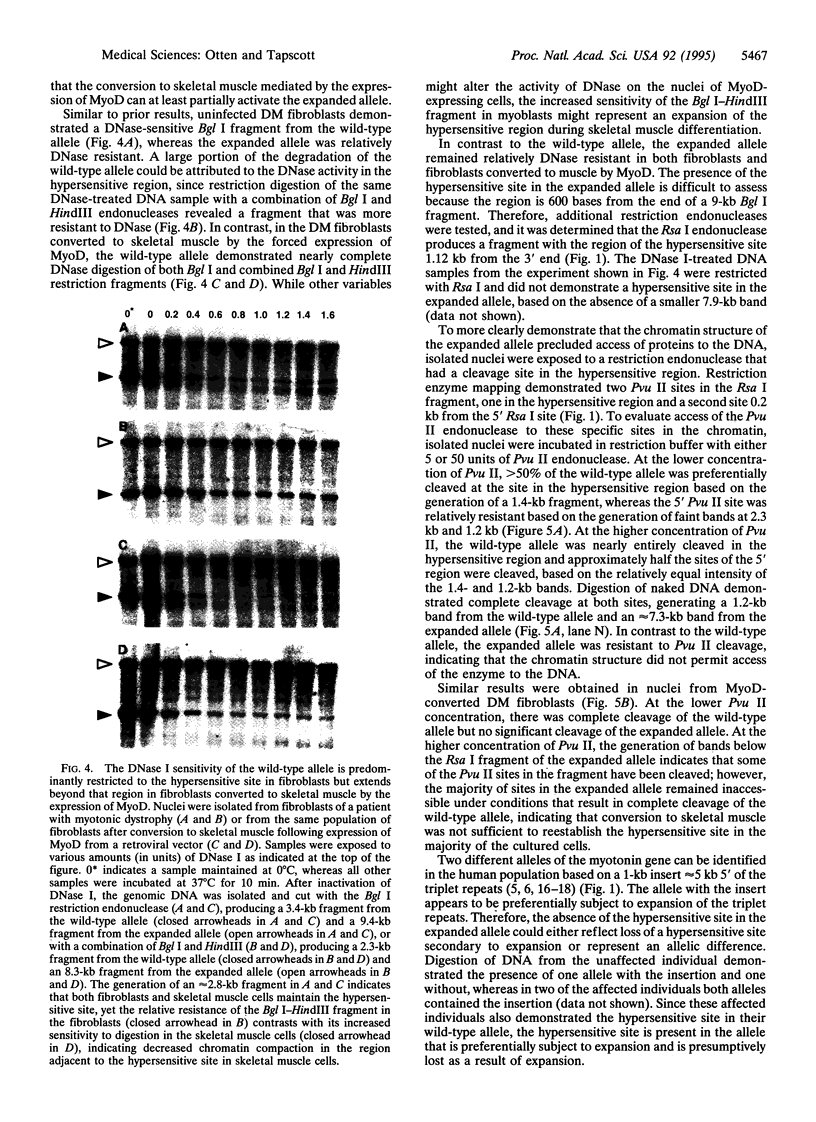
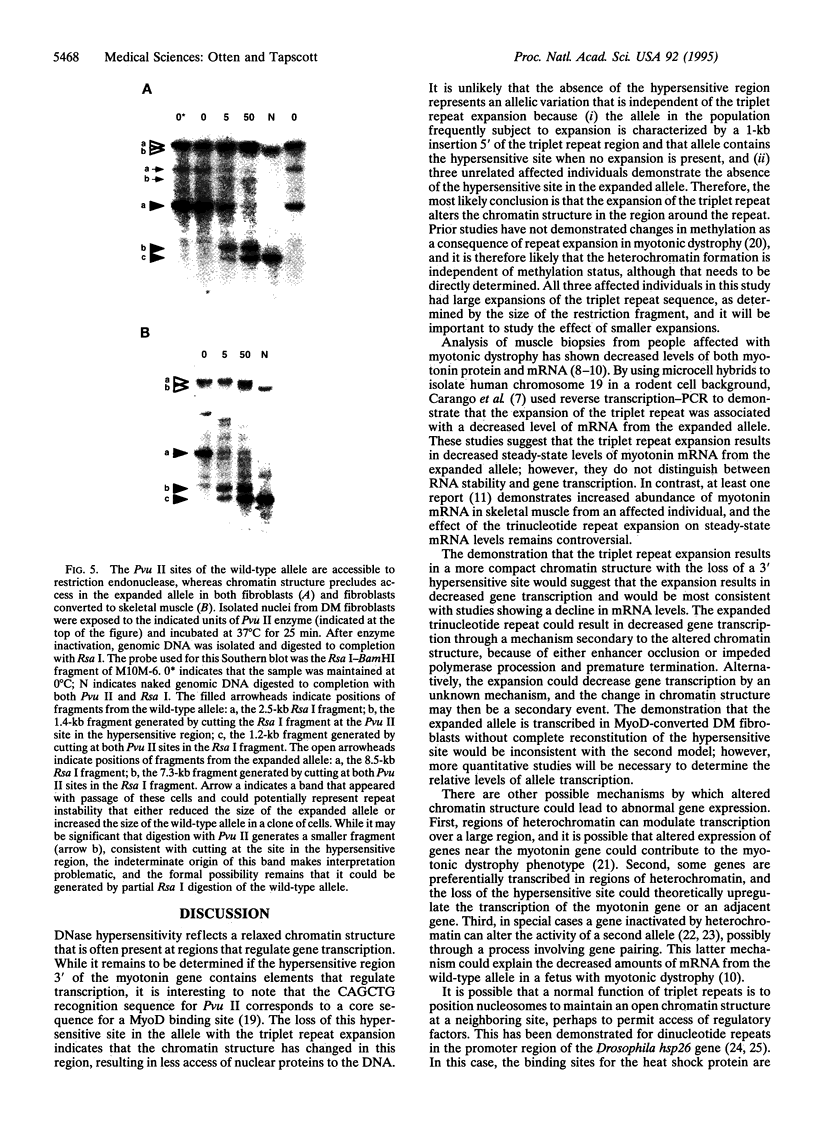
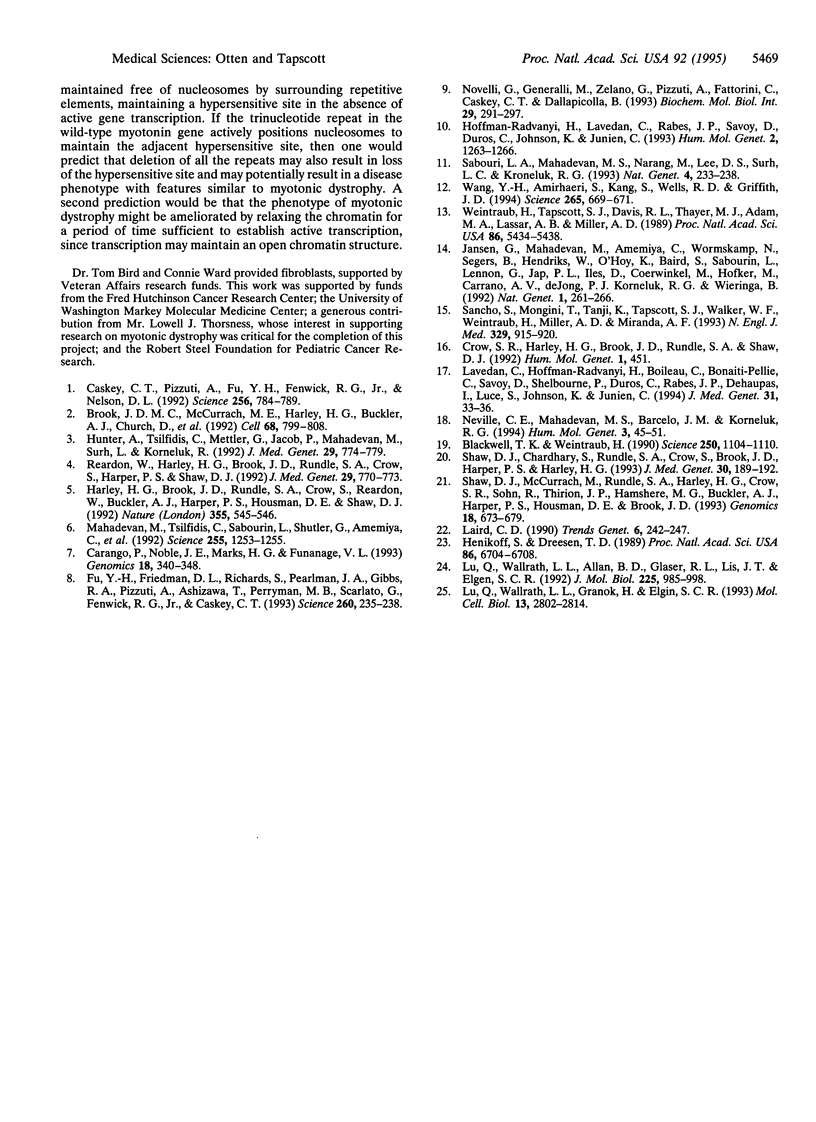
Images in this article
Selected References
These references are in PubMed. This may not be the complete list of references from this article.
- Blackwell T. K., Weintraub H. Differences and similarities in DNA-binding preferences of MyoD and E2A protein complexes revealed by binding site selection. Science. 1990 Nov 23;250(4984):1104–1110. doi: 10.1126/science.2174572. [DOI] [PubMed] [Google Scholar]
- Brook J. D., McCurrach M. E., Harley H. G., Buckler A. J., Church D., Aburatani H., Hunter K., Stanton V. P., Thirion J. P., Hudson T. Molecular basis of myotonic dystrophy: expansion of a trinucleotide (CTG) repeat at the 3' end of a transcript encoding a protein kinase family member. Cell. 1992 Feb 21;68(4):799–808. doi: 10.1016/0092-8674(92)90154-5. [DOI] [PubMed] [Google Scholar]
- Carango P., Noble J. E., Marks H. G., Funanage V. L. Absence of myotonic dystrophy protein kinase (DMPK) mRNA as a result of a triplet repeat expansion in myotonic dystrophy. Genomics. 1993 Nov;18(2):340–348. doi: 10.1006/geno.1993.1474. [DOI] [PubMed] [Google Scholar]
- Caskey C. T., Pizzuti A., Fu Y. H., Fenwick R. G., Jr, Nelson D. L. Triplet repeat mutations in human disease. Science. 1992 May 8;256(5058):784–789. doi: 10.1126/science.1589758. [DOI] [PubMed] [Google Scholar]
- Crow S. R., Harley H. G., Brook J. D., Rundle S. A., Shaw D. J. Insertion/deletion polymorphism at D19S95 associated with the myotonic dystrophy CTG repeat. Hum Mol Genet. 1992 Sep;1(6):451–451. doi: 10.1093/hmg/1.6.451. [DOI] [PubMed] [Google Scholar]
- Fu Y. H., Friedman D. L., Richards S., Pearlman J. A., Gibbs R. A., Pizzuti A., Ashizawa T., Perryman M. B., Scarlato G., Fenwick R. G., Jr Decreased expression of myotonin-protein kinase messenger RNA and protein in adult form of myotonic dystrophy. Science. 1993 Apr 9;260(5105):235–238. doi: 10.1126/science.8469976. [DOI] [PubMed] [Google Scholar]
- Harley H. G., Brook J. D., Rundle S. A., Crow S., Reardon W., Buckler A. J., Harper P. S., Housman D. E., Shaw D. J. Expansion of an unstable DNA region and phenotypic variation in myotonic dystrophy. Nature. 1992 Feb 6;355(6360):545–546. doi: 10.1038/355545a0. [DOI] [PubMed] [Google Scholar]
- Henikoff S., Dreesen T. D. Trans-inactivation of the Drosophila brown gene: evidence for transcriptional repression and somatic pairing dependence. Proc Natl Acad Sci U S A. 1989 Sep;86(17):6704–6708. doi: 10.1073/pnas.86.17.6704. [DOI] [PMC free article] [PubMed] [Google Scholar]
- Hofmann-Radvanyi H., Lavedan C., Rabès J. P., Savoy D., Duros C., Johnson K., Junien C. Myotonic dystrophy: absence of CTG enlarged transcript in congenital forms, and low expression of the normal allele. Hum Mol Genet. 1993 Aug;2(8):1263–1266. doi: 10.1093/hmg/2.8.1263. [DOI] [PubMed] [Google Scholar]
- Hunter A., Tsilfidis C., Mettler G., Jacob P., Mahadevan M., Surh L., Korneluk R. The correlation of age of onset with CTG trinucleotide repeat amplification in myotonic dystrophy. J Med Genet. 1992 Nov;29(11):774–779. doi: 10.1136/jmg.29.11.774. [DOI] [PMC free article] [PubMed] [Google Scholar]
- Jansen G., Mahadevan M., Amemiya C., Wormskamp N., Segers B., Hendriks W., O'Hoy K., Baird S., Sabourin L., Lennon G. Characterization of the myotonic dystrophy region predicts multiple protein isoform-encoding mRNAs. Nat Genet. 1992 Jul;1(4):261–266. doi: 10.1038/ng0792-261. [DOI] [PubMed] [Google Scholar]
- Laird C. D. Proposed genetic basis of Huntington's disease. Trends Genet. 1990 Aug;6(8):242–247. doi: 10.1016/0168-9525(90)90206-l. [DOI] [PubMed] [Google Scholar]
- Lavedan C., Hofmann-Radvanyi H., Boileau C., Bonaïti-Pellié C., Savoy D., Shelbourne P., Duros C., Rabes J. P., Dehaupas I., Luce S. French myotonic dystrophy families show expansion of a CTG repeat in complete linkage disequilibrium with an intragenic 1 kb insertion. J Med Genet. 1994 Jan;31(1):33–36. doi: 10.1136/jmg.31.1.33. [DOI] [PMC free article] [PubMed] [Google Scholar]
- Lu Q., Wallrath L. L., Allan B. D., Glaser R. L., Lis J. T., Elgin S. C. Promoter sequence containing (CT)n.(GA)n repeats is critical for the formation of the DNase I hypersensitive sites in the Drosophila hsp26 gene. J Mol Biol. 1992 Jun 20;225(4):985–998. doi: 10.1016/0022-2836(92)90099-6. [DOI] [PubMed] [Google Scholar]
- Lu Q., Wallrath L. L., Granok H., Elgin S. C. (CT)n (GA)n repeats and heat shock elements have distinct roles in chromatin structure and transcriptional activation of the Drosophila hsp26 gene. Mol Cell Biol. 1993 May;13(5):2802–2814. doi: 10.1128/mcb.13.5.2802. [DOI] [PMC free article] [PubMed] [Google Scholar]
- Mahadevan M., Tsilfidis C., Sabourin L., Shutler G., Amemiya C., Jansen G., Neville C., Narang M., Barceló J., O'Hoy K. Myotonic dystrophy mutation: an unstable CTG repeat in the 3' untranslated region of the gene. Science. 1992 Mar 6;255(5049):1253–1255. doi: 10.1126/science.1546325. [DOI] [PubMed] [Google Scholar]
- Neville C. E., Mahadevan M. S., Barceló J. M., Korneluk R. G. High resolution genetic analysis suggests one ancestral predisposing haplotype for the origin of the myotonic dystrophy mutation. Hum Mol Genet. 1994 Jan;3(1):45–51. doi: 10.1093/hmg/3.1.45. [DOI] [PubMed] [Google Scholar]
- Novelli G., Gennarelli M., Zelano G., Pizzuti A., Fattorini C., Caskey C. T., Dallapiccola B. Failure in detecting mRNA transcripts from the mutated allele in myotonic dystrophy muscle. Biochem Mol Biol Int. 1993 Feb;29(2):291–297. [PubMed] [Google Scholar]
- Reardon W., Harley H. G., Brook J. D., Rundle S. A., Crow S., Harper P. S., Shaw D. J. Minimal expression of myotonic dystrophy: a clinical and molecular analysis. J Med Genet. 1992 Nov;29(11):770–773. doi: 10.1136/jmg.29.11.770. [DOI] [PMC free article] [PubMed] [Google Scholar]
- Sabouri L. A., Mahadevan M. S., Narang M., Lee D. S., Surh L. C., Korneluk R. G. Effect of the myotonic dystrophy (DM) mutation on mRNA levels of the DM gene. Nat Genet. 1993 Jul;4(3):233–238. doi: 10.1038/ng0793-233. [DOI] [PubMed] [Google Scholar]
- Sancho S., Mongini T., Tanji K., Tapscott S. J., Walker W. F., Weintraub H., Miller A. D., Miranda A. F. Analysis of dystrophin expression after activation of myogenesis in amniocytes, chorionic-villus cells, and fibroblasts. A new method for diagnosing Duchenne's muscular dystrophy. N Engl J Med. 1993 Sep 23;329(13):915–920. doi: 10.1056/NEJM199309233291303. [DOI] [PubMed] [Google Scholar]
- Shaw D. J., Chaudhary S., Rundle S. A., Crow S., Brook J. D., Harper P. S., Harley H. G. A study of DNA methylation in myotonic dystrophy. J Med Genet. 1993 Mar;30(3):189–192. doi: 10.1136/jmg.30.3.189. [DOI] [PMC free article] [PubMed] [Google Scholar]
- Shaw D. J., McCurrach M., Rundle S. A., Harley H. G., Crow S. R., Sohn R., Thirion J. P., Hamshere M. G., Buckler A. J., Harper P. S. Genomic organization and transcriptional units at the myotonic dystrophy locus. Genomics. 1993 Dec;18(3):673–679. doi: 10.1016/s0888-7543(05)80372-6. [DOI] [PubMed] [Google Scholar]
- Wang Y. H., Amirhaeri S., Kang S., Wells R. D., Griffith J. D. Preferential nucleosome assembly at DNA triplet repeats from the myotonic dystrophy gene. Science. 1994 Jul 29;265(5172):669–671. doi: 10.1126/science.8036515. [DOI] [PubMed] [Google Scholar]
- Weintraub H., Tapscott S. J., Davis R. L., Thayer M. J., Adam M. A., Lassar A. B., Miller A. D. Activation of muscle-specific genes in pigment, nerve, fat, liver, and fibroblast cell lines by forced expression of MyoD. Proc Natl Acad Sci U S A. 1989 Jul;86(14):5434–5438. doi: 10.1073/pnas.86.14.5434. [DOI] [PMC free article] [PubMed] [Google Scholar]




